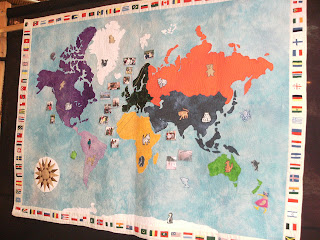Maths is an essential tool in the making of a quilt. You would think that all you have to do is to sew fancy patterns together and voila! A quilt - not so. Now that I have completed the central image, the next step is doing the patchwork blocks: patchwork stripes and courthouse steps, I believe. The first thing which I have to do is to cut out lots and lots and lots of measured strips in a variety of fabrics. Cutting out strips is really easy, as long as you have a rotary cutter, a quilter's non-slip ruler and a self-healing mat (I love the name, basically it is a mat which you can use a sharp blade on, the pizza-looking rotary cutter, and it doesn't score the surface) then Bob's your uncle! Stage one completed: lots and lots (I do love the word) of inch and a half strips.

Combining the colours is hard but not impossible. As I told you all, I really went overboard in my buying of African fabrics: so overboard that I was drowning in them! Now is the time to put them all together to create something pleasing to the eye. Whilst cutting out the strip, I pondered on that problem; was everything going to be garish or would I be able to do it tastefully? The solution was to sew it up and see.

I combined shades together, keeping in mind that I am going to be working on two designs (I've also seen another which I do like called Seminole) and then sat at the sewing machine and produced endless strips and combinations of cloth. Doing this really bring to mind that '80s advert for mashed potatoes; the aliens amusingly, then hilariously observe us humans peeling, boiling and mashing the potatoes and then combining it all back together again - I remember the punch line 'For mash get Smash!' - well doing patchwork is a bit like that. You cut up endless pieces of cloth, sew it back together in some fashion, cut it up again and then sew it back together in a different fashion!!! Some people do ask why, well the only answer that I can give is the satisfaction of creating something unique. In this stage the important equipment is the cutting mat, rotary cutter, sewing machine and ironing board because a lot of cutting and putting back together goes on. Overall I was very pleased with the finished effect: very nice!
 |
| Courthouse Step |
 |
| Patchwork Stripes |
After creating all those blocks my next job was to place it around the central image: where is my calculator! I measured the central image and the patchwork stripes and calculated how many were going to fit around it, all good so far. This was working out a bit too perfect and alas, the inevitable, I was a bit short on the sides. This is why I say that you have to be a mathematician to be a quilter because you have to work out how everything will fit together and if they don't you have to factor in fillers like posts and sashings. Sashings are columns or strips of fabrics which separate individual blocks and posts are little squares which goes on the corners of these strips. The maths comes in when you have to calculate available space and the size in which to make these fillers which is not easy as a majority of patchwork blocks is calculated in inches (and I tend to work in both); then you have to find suitable fabrics for these posts and sashes and you are liable to end up buying even more fabric and I definitely have enough of that!
Patchwork and quilting is an expensive hobby as one is always buying: I've had to go out, back to Fabrics Galore, and buy extra fabric for my sashing and then had to change the colour combination as they had run out of the one which I had originally bought. And you know what the next sentence is going to be: I saw another bit of fabric which I really liked and could blend into the quilt, so being of weak purse - I bought it!
My maths skills is not great and I will do something about it this year - a maths course! I had calculated how much space I had available, so I proceeded to make the fillers for it and attach them to the patchwork blocks, only to find that I was still short! What had gone wrong? Oh yes, I forgot to minus the seam allowances in my calculation! Well, central image, you are now going to become a bit smaller because what I have just labouriously completed has to fit onto you and I ain't unpicking!









































